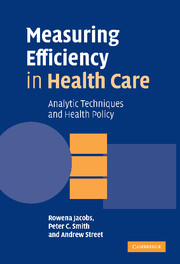Book contents
- Frontmatter
- Contents
- List of figures
- List of tables
- Preface
- Acknowledgements
- List of abbreviations
- 1 Efficiency in health care
- 2 The components of an efficiency model
- 3 Stochastic frontier analysis of cross-sectional data
- 4 Stochastic frontier analysis of panel data
- 5 Data envelopment analysis
- 6 The Malmquist index
- 7 A comparison of SFA and DEA
- 8 Unresolved issues and challenges in efficiency measurement
- 9 Some alternative approaches to measuring performance
- 10 Conclusions
- Appendix: Data description
- References
- Author index
- Subject index
5 - Data envelopment analysis
Published online by Cambridge University Press: 10 December 2009
- Frontmatter
- Contents
- List of figures
- List of tables
- Preface
- Acknowledgements
- List of abbreviations
- 1 Efficiency in health care
- 2 The components of an efficiency model
- 3 Stochastic frontier analysis of cross-sectional data
- 4 Stochastic frontier analysis of panel data
- 5 Data envelopment analysis
- 6 The Malmquist index
- 7 A comparison of SFA and DEA
- 8 Unresolved issues and challenges in efficiency measurement
- 9 Some alternative approaches to measuring performance
- 10 Conclusions
- Appendix: Data description
- References
- Author index
- Subject index
Summary
Introduction
Data envelopment analysis (DEA) has become the dominant approach to efficiency measurement in health care and in many other sectors of the economy (Hollingsworth 2003). While the parametric approach is guided by economic theory, DEA is a data-driven approach. The location (and the shape) of the efficiency frontier is determined by the data, using the simple notion that an organisation that employs less input than another to produce the same amount of output can be considered more efficient. Those observations with the highest ratios of output to input are considered efficient, and the efficiency frontier is constructed by joining these observations up in the input-output space. The frontier thus comprises a series of linear segments connecting one efficient observation to another. The construction of the frontier is based on ‘best observed practice’ and is therefore only an approximation to the true, unobserved efficiency frontier.
Inefficient organisations are ‘enveloped’ by the efficiency frontier in DEA. The inefficiency of the organisations within the frontier boundary is calculated relative to this surface (Grosskopf and Valdmanis 1987; Charnes et al. 1994; Cooper, Seiford and Tone 2000). This chapter outlines the distinctive features of the DEA methodology, along with key issues in specifying and judging the quality of a DEA model.
The DEA methodology
DEA literature traditionally uses the terminology of a decision-making unit (DMU) for each of the units of analysis under scrutiny, a term coined by Charnes, Cooper and Rhodes (1978) in their seminal paper which introduced DEA.
- Type
- Chapter
- Information
- Measuring Efficiency in Health CareAnalytic Techniques and Health Policy, pp. 91 - 128Publisher: Cambridge University PressPrint publication year: 2006
- 1
- Cited by



